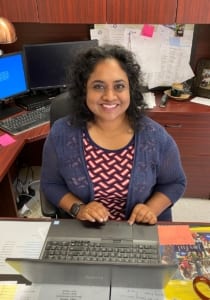Cents and Sensibility
Alabama principal encourages inspiration, one penny at a time.
Topics: School Culture and Climate

Dilhani J. Uswate
As principal of Rocky Ridge Elementary School in Hoover, Alabama, Dilhani “Dr. Dil” Uswatte built upon her 13 years of experience as a math and science teacher to build an internationally accredited STEAM school, using the arts to support other subjects. The 2020 NAESP Principal of the Year for Alabama is a longtime proponent of pre-K education, and her ongoing impact on mentoring has helped her garner multiple recognitions.
A champion of intentionality, Dr. Dil created the Power of a Penny project (bit.ly/3r9WZ1h) at Rocky Ridge to remind people of the value of inspiration. It encourages students and educators alike to offer a penny to anyone who inspires them—literally paying it forward with a small reward and personal recognition. Seeing children offer up hundreds of pennies in the first weeks, Dr. Dil expanded the project’s reach to encourage mindful inspiration wherever it exists.
“Hopefully, when people see a penny, it is a reminder to intentionally notice those around us, recognize them, and encourage them to continue their great work,” Uswatte says. “It is my hope that this project continues to build not only our community, but also our world.”
What makes pre-K education so important to future success in school?
Birth to age 5 are critical years, especially for brain development. Research shows that positive learning experiences during this time can dramatically affect not only future academic growth, but social and emotional growth, as well. Students in our pre-K program seem more confident and ready to learn when they enter kindergarten.
What is the mission you’ve established for Rocky Ridge, and why is that important?
We aim to create a learning environment that’s focused on building a community of lifelong learners who are committed problem-solvers and responsible global citizens. When we work together as a community (parents, students, teachers, and local businesses), we can dramatically improve the quality and joy of education.
Why and how did you seek out private funding to support your school’s goals?
Learning has meaning for us when we can see how it applies to the “real” world, so why not get the real world involved? We continuously reach out to our parents to help make connections in the community. We collaborate regularly with local universities. If we hear of grants, we try to apply for them. If you don’t ask or apply, nothing will happen.
When people see a penny, it is a reminder to intentionally notice those around us.
How do you use the arts to integrate or effectuate the other STEAM studies?
We realized that to creatively integrate science, technology, engineering, and math, the arts are the natural glue that brings them all together. We often use a design-thinking framework to solve problems, requiring students to use empathy (drama), collect and share ideas (reading, writing, speaking, and listening), and build or design a prototype (graphic arts, sculpture, etc.).
What have you done in order to keep your goals on track during the pandemic?
We have regular team meetings to look at the data and plan next steps. We also have teams that focus on growing our positive culture and climate, and we have weekly check-in meetings to plan and support each other. Last year, we started a house system similar to [the] Ron Clark [Academy] to create more of a family environment. Our theme this year was “Many Houses, One Family.”

